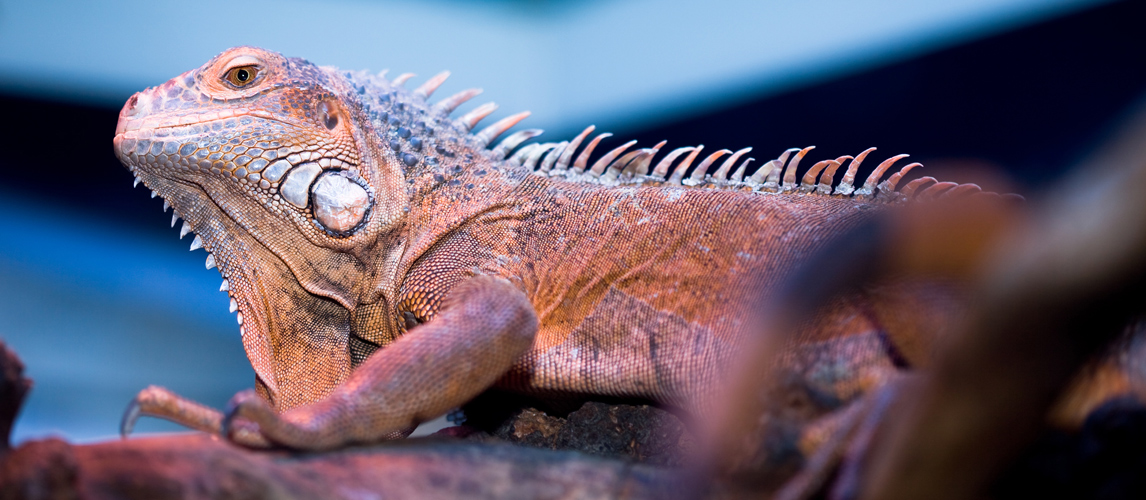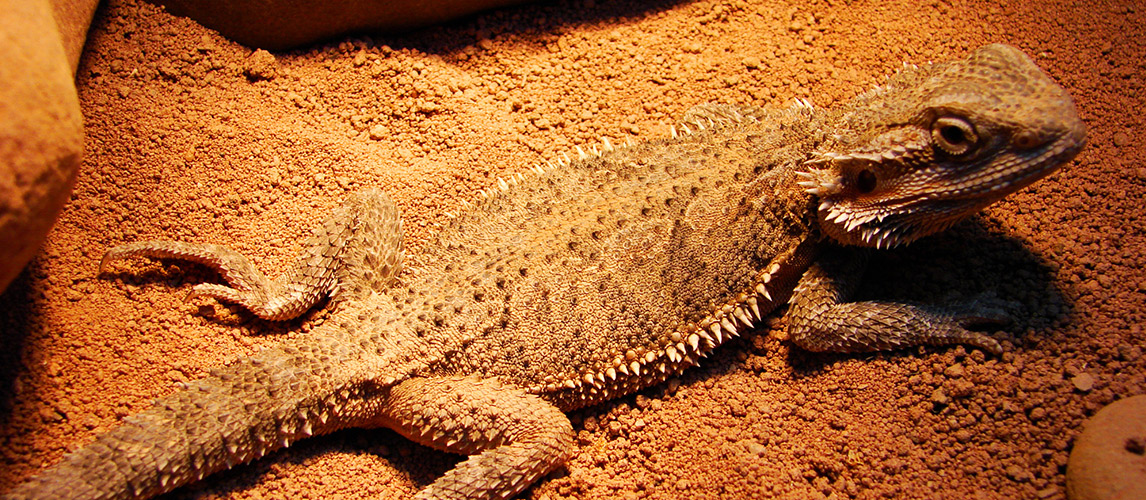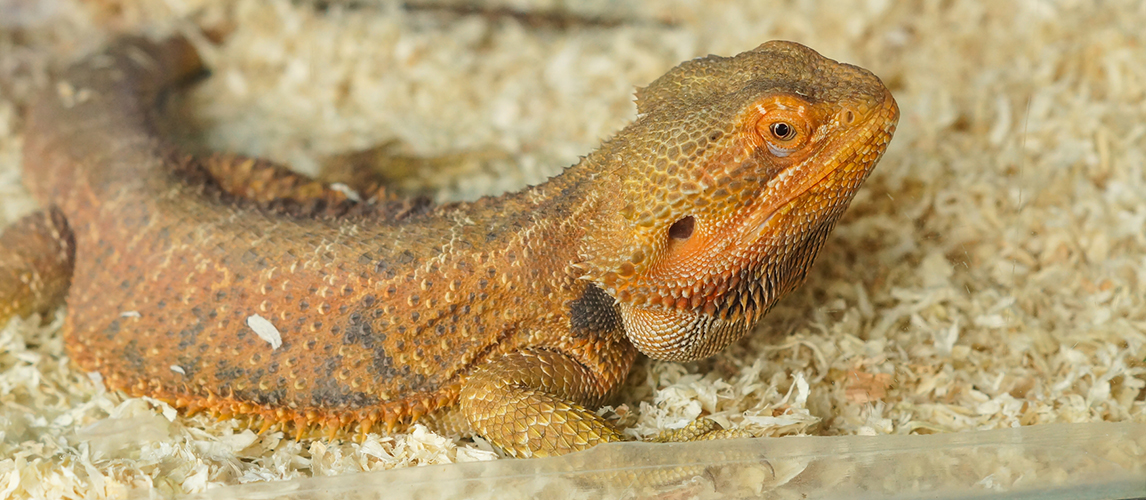There are many reasons that the Pogona Vitticeps, or bearded dragon for those of us not fluent in latin, are one of the most popular lizard pets in the USA. I’ve seen many people who swear by the cuteness of their ‘beardies’, and they are fascinating to watch, pretty tame, and resilient. If you have recently adopted your own bearded dragon, or are looking into buying a lizard, it is a good idea to learn how to care for them. As we always aim to be as helpful as possible, here is our complete introduction and guide to caring for a bearded dragon.
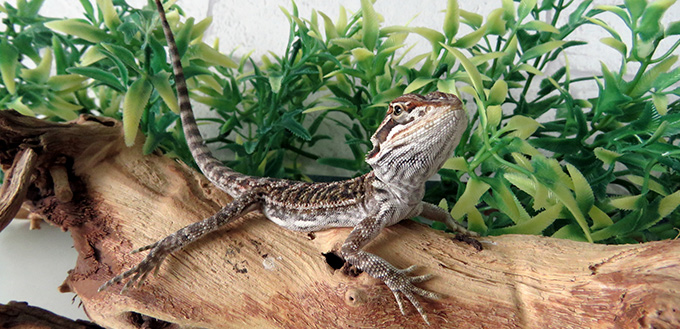
Bearded Dragon Behavior
Bearded dragons are both interesting and entertaining pets. They exhibit a lot of behaviors and, luckily, they stay awake during the day so you get to see all of it! Here is a quick list of five of their most common behaviors with an explanation of what it could mean.
- Brumation, or hiding and sleeping in winter, is similar to hibernation and can be alarming if not expected. Sleep timings can vary from weeks to months and does not happen in bearded dragons that are younger than one year old.
- Arm waving is a favorite behavior because it looks very cute. It is their way of acting submissive so they may wave at you, or another, bigger bearded dragon.
- Beard flaring is the behavior that helped to give the dragon its name. It is a defensive manoeuvre and shows that they feel under threat. You should back off if you see this.
- Black bearding is one of many signs of stress, but could also be a sign of dominance when done to another bearded dragon. Look out for other signs of stress to ascertain how they are feeling.
- Digging is one of these other signs of stress, but could also be a sign of pregnancy in female bearded dragons, or may just be their attempt to make a comfortable place to sit. If you suspect pregnancy, make a greater effort to provide your reptile with sufficient amounts of calcium in her diet.
Bearded Dragon Habitat
If you have recently bought a hatchling bearded dragon, they are probably only about 4 inches long. They are sweet little things, but these cute baby lizards can grow to be almost 2 feet in length, so you have to be prepared to provide them with a much larger tank to suit their needs.
A hatchling will be quite happy with a 20-gallon tank, but you will quickly need to upgrade this to a 75-gallon aquarium. This is adequate space for one bearded dragon. It is not advised that you have more than one bearded dragon in a tank. The bigger one is likely to bully and attack the smaller and they will experience stress and competition.
Related Post: Bearded Dragon Enclosure
Once you have found the right enclosure you can construct their habitat. Cover the top of the enclosure with a screen to ensure the tank gets enough ventilation and install a spotlight to create a basking spot of 100 degrees. The remainder of an indoor tank needs full-spectrum UVB lighting. This mimics the nutrients that your bearded dragon would usually get from the sun, such as vitamin D3.
Related Post: UVB Bulb For Bearded Dragon
Like many lizards, bearded dragons thermoregulate. This means they move between hot and cold areas to help them regulate their temperature. Put your spotlight at one end of the tank to create the hot area. The cool zone should be kept at around 80 degrees. Night-time temperatures can be reduced to around 65 degrees. Thermometers are essential, and you can use a wide variety of devices to manage these changes. Make sure these devices will not burn your lizard, or keep them up at night.
In terms of substrate, it is better to avoid loose substrate, such as sand, for hatchlings or young bearded dragons as they may eat it, causing intestinal impaction. Newspaper is a better choice and adult bearded dragons will also be happy using this material. If you wish to mimic their natural habitat by using sand, you must be careful and follow this advice:
- Consider ‘reptile sand’. It is considered ‘digestible’, but its safety is often debated.
- Always follow the manufacturer’s suggestions to ensure your pet is as safe as they can be.
- If you mix your sand with any clean soil, ensure it has not been treated with fertilizers or pesticides.
- Do not put their food directly on the substrate. Always offer your bearded dragon food from a shallow dish to limit accidental sand eating.
Related Post: Substrate for Bearded Dragons
Bearded dragons can also have outdoor enclosures if it you live somewhere warm. When constructing an outdoor cage, make sure they have an area to bask in the sun, shade for when it becomes too hot, and shelter in case of an unexpected downpour.
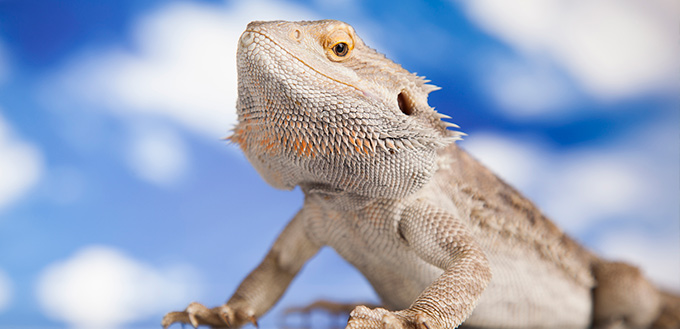
Bearded Dragon Diet & Nutrition
Now you know where your bearded dragon should live, you should know how to feed it. If you are new to lizards, you should be prepared that you will need to feed them insects. If you find this gross or creepy, owning a lizard is not for you. Unlike other species, however, the bearded dragon is an omnivore. This means they can also eat some veggies. Don’t attempt to make your lizard vegetarian, however, as you are likely to result in denying them important protein nutrients.
Typically, your bearded dragon will eat:
- Fruit, such as bananas, apples, kiwi, mango and melons
- Vegetables, such as watercress, dandelion, rocket, collard and carrots
- Insects, such as dubia roaches, phoenix worms, locust, mealworms, wax worms, and crickets.
- They can also eat pinky mice as a protein source
They should be fed two to three times a day, and the bulk of their diet should be insects. To ensure they get all the nutrients they need, you should balance their food to 5% fruit as a treat, 25-50% vegetables and the rest insects. The younger your bearded dragon is, the more insects they need. A newborn hatchling will eat almost entirely insects, and then you should slowly reduce the amount of insects you feed them as they become an adult.
When you feed insects to a bearded dragon, they should first be coated in vitamin supplement powder and calcium. Some owners suggest coating vegetables and fruit in this powder as well, while others argue you should only do this process five times a week. It is easy to coat their food. Simply put the food in a bag with the powder and shake. You should also consider the fat content of the insect. You may want to consider wax worms, for example, as treats, while crickets and locust make better daily meals.
It is possible to buy a manufactured feed or prepared diet for a bearded lizard. It is worthwhile consulting the pet store that you bought them from, or a vet, to ensure the feed you are buying will fully support their nutritional needs.
Provide a dish of water for your beardie that is always full and regularly changed. The dish should be large enough for them to soak in, should they want to bathe or cool themselves. You should also spray their enclosure using a spray bottle. They often lick the droplets of water that this produces, but don’t let their environment become too humid. Their ideal humidity level is between 20% and 30%.
If you are worried that your lizard is not drinking enough water from their dish, perhaps because they are not interested by it, you can also spray their food before serving it to provide a little extra hydration.
Bearded Dragon Grooming & Hygiene
One of the many reasons that bearded dragons are so popular are because they are so comfortable being handled. Some aficionados even argue that they like it! It is certainly true that if you go to a reptile show, you may well see bearded dragons comfortably perched on their owner’s shoulders or scuttling around a table. There are, however, some crucial rules about handling these lizards that will keep both you and them safe as bearded dragons may harbor bacteria that can be spread to humans.
- Always wash your hands before and after handling them.
- Always wash your hands before and after handling anything your lizard has touched.
- Keep them away from toddlers, the elderly, pregnant women or anyone who may have a weakened immune system.
- Don’t let your bearded dragon move freely about the home, and wipe down the surfaces they touch with disinfectant.
- Definitely keep them out of the kitchen and dining areas.
- Don’t keep them outside their tank for long enough for them to get cold.
- Do not handle a new bearded dragon. Give them at least three to four days to adjust to their new home and to settle in.
Another important hygiene issue to understand is shedding. While a bearded dragon does shed it’s skin, unlike some other lizards it does not do it in one go. Small sections are shed at a time, and you should not attempt to intervene or pick it off yourself. If you wish to encourage the shedding, regular bathing and showering could help. You must also maintain a high standard of cleanliness for their environment. Do not let them live in their own shedding.
This leads us to another vital hygiene concern – how often should you clean a bearded dragon’s tank? As a general rule, daily care includes:
- Removing their droppings
- Removing any uneaten food
- Top up their drinking water whenever it seems to be getting low
- Replacing their drinking water, even if it looks untouched
- Clean their food and drinking bowls
Once a week, you should:
- Remove any furnishing for cleaning with a pet-safe disinfectant
Once a month, you should:
- Remove everything from the tank
- Clean the actual enclosure with pet-safe disinfectant
- Clean all furnishings and accessories
- Provide fresh, brand new substrate
You can also choose to use this monthly deep-clean as an opportunity to use a pet-safe deodorizer on their environment if you are concerned about bad smells.
Bearded Dragon Common Health Problems
A normal lifespan for a bearded dragon is between 6 to 10 years, but some have reportedly lived for almost 20 years. They can be quite the commitment. Keeping your bearded dragon’s enclosure hygienic and safe should allow them to live this long and happy life. As you obviously want to do everything you can to avoid having a poorly pet, here are the most common health issues that can arise for the bearded dragon. The more you know, the more you will be able to prevent it or, at least, recognize the symptoms.
1. Dehydration
The cause of dehydration is pretty self explanatory. If you are worried that your reptile is suffering from dehydration, look for these symptoms:
- A lack of appetite
- Lethargy
- Sunken eyes
- Wrinkled skin
- Drinking a lot when offered water, whether through licking themselves, their environment or in their bowl
It can be difficult to get your beardie to drink from their bowl, which is why you might need to get creative with sprays and food. If you absolutely can’t get them to drink, take them to your vet.
2. Impaction
Impaction is caused by eating something, like sand, that they cannot digest. If you think they may be struggling to digest something, check if they have:
- Lethargy
- A lack of appetite
- Constipation
- Foreign objects in their stool
- Poorly digested stools
- Paralysis in back legs
It is best to go straight to the vet, but you can also try a warm bath and a gentle belly rub. You should also check that their basking spot has the right temperature as basking can aid digestion and you should discuss switching to more digestible food with your vet.
3. Metabolic Bone Disease (MBD)
A poor balance of the vital minerals calcium and vitamin D3 will result in MBD. Symptoms include:
- A reduction in appetite
- A reduction in weight
- Brittle bones
- Bowed legs
- Bumps in the legs or spine
- Deformation
- Limb paralysis
- A malnourished appearance
- Stool issues
- Stunted growth
- Swollen limbs
- Twitching toes or legs
- Lethargy
Like most concerns, you should head to the vet if you suspect MBD. They will suggest how you can readjust their mineral levels. You should also double check that their habitat is optimal for their health, such as temperature and water provision.
4. Parasites
Most parasites come from your lizard eating something infected, although this isn’t the only type of parasite, as we will soon discuss. Symptoms of an ingested parasite include:
- Discoloration of the stool
- Particularly foul smelling stools
- A lack of appetite
- Poorly digested stool
There is really only one simple solution for parasites – go to a vet. They will be able to ascertain which parasite it is, and what the solution is.
5. Mites
Another form of parasite are mites that may live on your reptile and in their environment are mites. Signs that your bearded dragon may have mites include:
- Lethargy
- A reduced appetite
- Bite marks
- The mites themselves, either in the enclosure on or the crevices of the lizard’s body.
You must quarantine a reptile suffering from mites to prevent them spreading. Disinfect the enclosure with a suitable mite treatment spray designed for reptiles and then air it out. Give the bearded dragon a warm bath with diluted betadine and then use a cotton swab to clean under legs and in the cracks in the ‘beard’. If you want further help or instruction, contact your vet.
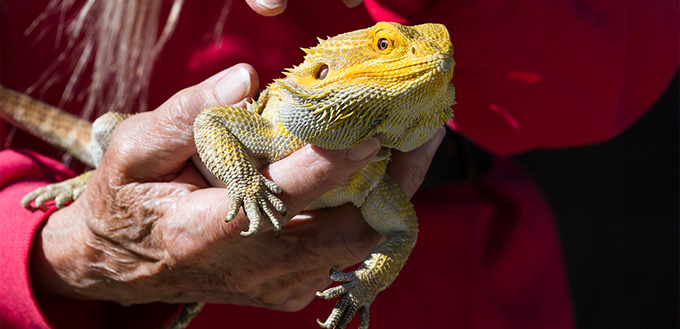
6. Respiratory Infection
A bacterial infection that affects the lungs is, unfortunately, all too common when there are humidity or hygiene issues. There are plenty of symptoms to look out for, such as:
- Lethargy
- A lack of appetite
- Leaving their mouth open frequently
- Visible breathing difficulties
- Wheezing or clicking noises from the mouth
- Mucus near the mouth or nostrils
Infections can get bad quite quickly so bring them to the vet, but you can also help by checking that the humidity and temperature of their environment is ideal, and you should clean their tank.
7. Mouth Rot
Another bacterial infection that could plague your bearded dragon affects their mouth. If you have concerns that your pet is suffering from mouth rot, look out for:
- Lethargy
- A reduced appetite
- Black of loose teeth
- Discoloration in the mouth, particularly white, yellow or gray.
As with other infections, visit a vet as soon as possible. You should also check, adjust and clean their living quarters.
8. Tail Rot
Although the name is similar to mouth rot, tail rot usually occurs due to a physical trauma, or shedding problems. Look out for:
- A black tail
- A tail that is hard, shriveled or progressing towards the body
You should never break off the tail, but you can use a warm daily bath to encourage the rot to soften and then fall off. You should also clean their enclosure to prevent the tail from becoming infected. If you think it has become infected or if you have other concerns, do not hesitate to contact your vet.
9. Yellow Fungus
A highly contagious disease, yellow fungus occurs when a bearded dragon lives in unhygienic conditions. Symptoms of yellow fungus include:
- Lethargy
- A reduced appetite
- Yellow or Brown Patches on their scales that may be spreading
This medical condition warrants a visit to the vet as soon as possible. The patient should also be quarantined and the enclosure should be cleaned.
Remember, if you have any concerns or worries, it is always better to go to the vet.
Related Post: Veiled Chameleon – Complete Care Guide and Introduction
Sources:
- Bearded Dragons for Sale? They—Like All Other Reptiles—Are Not ‘Pets’, PETA
- Kathleen R. Smith, Colour Change On Different Body Regions Provides Thermal And Signalling Advantages In Bearded Dragon Lizards, The Royal Society
- Bob Doneley, BVSc, FACVSc, Caring For The Bearded Dragon, CABI



